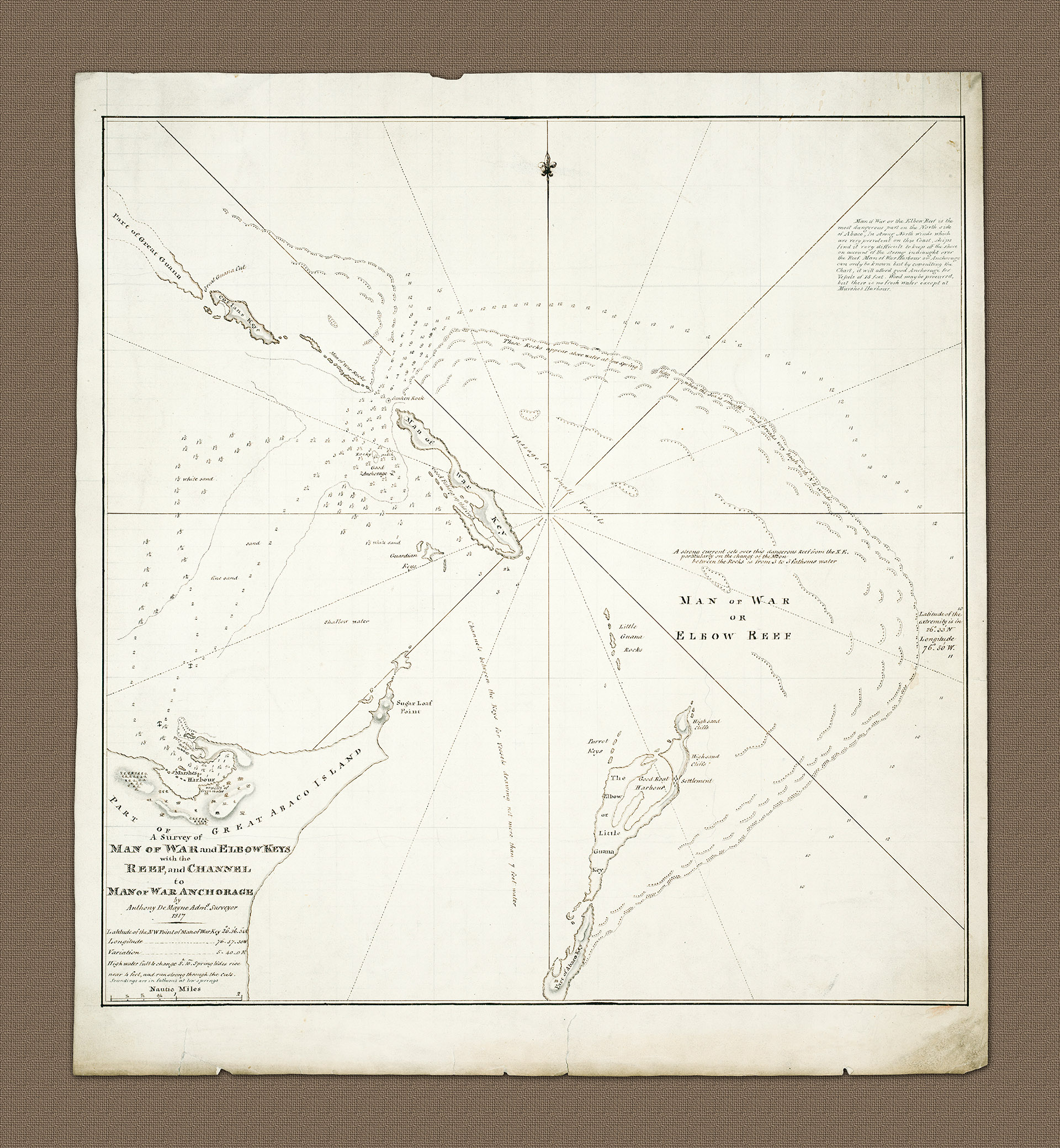A726 - Man of War and Elbow Keys, and Channel to Man of War Anchorage
The overall effect of this beautiful survey by Anthony De Mayne, Admiralty Surveyor is to engage the viewer in the detail and information provided through the artistic presentation. It give the sensation of comfort to the sailor simply because every inch of the area has been visited by De Mayne and expertly recorded. It is part of a larger survey conducted by De Mayne (See Heritage Charts A724, A725 & A727).
- 1817
- Anthony De Mayne
- h24.5" x w22.5"
- P
Anthony De Mayne, the Admiralty surveyor charged with surveying the Outer Abaco Islands, reached Marsh harbour and its outer keys in 1817. On the top-right of the chart De Mayne wrote some observations which include that Man of War and Elbow Reef are 'the most dangerous part of North Abaco' and that in strong winds 'ships find it very difficult to keep off the shore on account of the strong indraught over the reef'.
The surveyor, despite the artistic presentation of his chart is doing his job. His soundings, marking of the reefs, shoals, sand-banks and other obstacles to the passing sailor are clearly done with a view to presenting the most accurate picture of how to survive in some of the most treacherous waters in the Bahamas. De Mayne includes the warning that only boats drawing less than 7 feet and measuring no more than 15 feet may make it over the reef and access the anchorages, but even then only with the assistance of this survey (or the resulting published chart).
Marsh Harbor is, today, a major hub for access to the outer Cays with both an airport and water taxi service along with shops and a post office. In 1817 Marsh Harbor was the only source of fresh drinking water, something De Mayne as a surveyor was bound to record along with mention of wood for replenishment of ships and boats. The Elbow or Little Guana Key, as De Mayne labels it, is of course modern day Elbow Cay and the settlement depicted is Hope Town. Hope Town is, today, one of the most thriving of all Abaco settlements.
The settlement at Hope Town was founded in 1785, as part of the great migration of Loyalist supporters from mainland America. The town and harbor had quickly established itself as a center for ship building and 'wracking'. In 1864 the British completed the famous lighthouse which is now one of the most recognizable landmarks in the Abacos.
The 'style' of this survey, is very much in keeping with the other surveys produced by De Mayne in this series. On a point of accuracy, and out of interest, De Mayne gives the North West point of Man of War 'Key' a latitude of 26° 36" 36", and a longitude of 76° 57" 30". With the benefit of modern satellite technology, the same points are in fact at 26° 61" and 77° 02".
Tempting as it may be to test De Mayne's skill as a surveyor by sailing and navigating by his survey, Heritage Charts accepts no responsibility for such actions and advises against such activity.
Not until after the American Revolutionary War had finally ended in 1783 did the Bahamas and the outer islands of the Abaco take-on a noticeable, if not significant, role in history: With the expulsion of Loyalist sympathizers from their colonial holdings in 1782 the British government, which in itself had only until November 1783 to vacate the city of New York, it's last holding in America, struggled to find refuge for it's vanquished and now penniless supporters.
England apart, Canada was one option, the Abaco islands was the other. The first ship full of emigres had left New York in August 1783 for a land which British surveyor John Wilson described as being '..one fifth part of the face of the country is nothing but rock'. He went on to describe the suitability of whatever soil there was as being suitable only for; cotton, vegetables & guinea corn. As an estimation of sustainability Wilson's survey proved to be optimistic in as much as it would take a higher level of expertise and land management to fulfil the promises beyond the hopes of both the emigres and the British government, which frankly didn't exist.
By the 1790s civil unrest was boiling over, especially amongst the races. Initially, it seems, indenture had been implemented forcing even free blacks to 'belong' to whites. Many of the former slaves who had 'emigrated' complained that they thought, under British law that they would be free. With shortages of all kinds social order was further under threat. Agriculture had failed due to inefficient land management, cotton never developed as hoped on Abaco, although it had on the southern islands of Eleuthera.
When the provisions supplied by the British government had run out, starvation had taken hold for many. Many of the original Loyalist immigrants had moved away to Nassau or beyond. Only fledgling settlements and communities survived. A second immigration of people, this time from the more southerly Eluethera Islands, brought expertise in boat building, fishing and wrecking and these three industries in particular proved the way forward for many with towns such as New Plymouth on Green Turtle Cay and Hope Town on Elbow Cay springing-up and developing as a direct result of these industries.
References: 'Abaco: The History of an Out Island and its Cays'. Steve Dodge, Professor of History, Millikin University, Third Edition (2005). White Sound Press.
- Man of War and Elbow Keys with the Reef, and Channel to Man of War Anchorage


